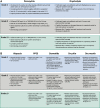Dermatologic Adverse Events Associated with Selective Fibroblast Growth Factor Receptor Inhibitors: Overview, Prevention, and Management Guidelines
- PMID: 33021006
- PMCID: PMC7873330
- DOI: 10.1002/onco.13552
Dermatologic Adverse Events Associated with Selective Fibroblast Growth Factor Receptor Inhibitors: Overview, Prevention, and Management Guidelines
Abstract
Fibroblast growth factor receptor (FGFR) tyrosine kinases, which are expressed on the cell membrane, are involved in a wide range of biological functions such as cell proliferation, survival, migration, and differentiation. The identification of FGFR fusions and other alterations in a wide range of solid tumors, including cholangiocarcinoma and bladder cancer, has resulted in the development of several selective FGFR inhibitors for use in these indications, for example, infigratinib, erdafitinib, derazantinib, pemigatinib, and futibatinib. In addition to the typical adverse events associated with tyrosine kinases, the FGFR inhibitors appear to give rise to a number of adverse events affecting the skin. Here we describe these skin events, which include the more common nail adverse events (e.g., onycholysis), palmar-plantar erythrodysesthesia syndrome, and stomatitis, as well as less common reactions such as calciphylaxis. This review aims to provide oncologists with an understanding of these dermatologic events and proposes guidelines for the management of treatment-emergent dermatologic adverse events. Awareness of possible adverse events associated with specific drugs should allow physicians to educate patients as to what to expect and implement effective management plans at the earliest possible opportunity, thereby preventing premature discontinuation while maintaining patient quality of life. IMPLICATIONS FOR PRACTICE: Identification of fibroblast growth factor receptor (FGFR) aberrations in cholangiocarcinoma and bladder cancer led to development of selective FGFR inhibitors for these indications, based on clinical benefit and safety profiles. The most frequent adverse events (AEs) include those affecting skin, hair, and nails, a unique class effect of these agents. These are usually mild to moderate in severity. This work reviewed skin AEs reported with FGFR inhibitors and provides management guidelines for physicians, aiming to increase awareness of skin events and provide effective treatment strategies. Early intervention and effective management may improve treatment adherence, optimize outcomes, and improve quality of life.
Keywords: Dermatologic; Drug-related side effects and adverse events; Fibroblast growth factor receptor; Guidelines.
© 2020 The Authors. The Oncologist published by Wiley Periodicals LLC on behalf of AlphaMed Press.
Conflict of interest statement
Figures



References
-
- Turner N, Grose R. Fibroblast growth factor signalling: From development to cancer. Nat Rev Cancer 2010;10:116–129. - PubMed
-
- Ross JS, Wang K, Khaira D et al. Comprehensive genomic profiling of 295 cases of clinically advanced urothelial carcinoma of the urinary bladder reveals a high frequency of clinically relevant genomic alterations. Cancer 2016;122:702–711. - PubMed
Publication types
MeSH terms
Substances
Grants and funding
LinkOut - more resources
Full Text Sources
Medical

